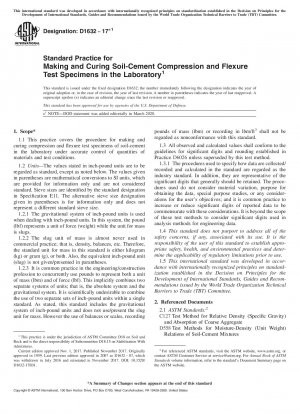ASTM D1632-17e1
Standard Practice for Making and Curing Soil-Cement Compression and Flexure Test Specimens in the Laboratory
- Standard No.
- ASTM D1632-17e1
- Release Date
- 2017
- Published By
- American Society for Testing and Materials (ASTM)
- Latest
- ASTM D1632-17e1
- Scope
- 1.1 This practice covers the procedure for making and curing compression and flexure test specimens of soil-cement in the laboratory under accurate control of quantities of materials and test conditions. 1.2 Units—The values stated in inch-pound units are to be regarded as standard, except as noted below. The values given in parentheses are mathematical conversions to SI units, which are provided for information only and are not considered standard. Sieve sizes are identified by the standard designation in Specification E11. The alternative sieve size designation given in parentheses is for information only and does not represent a different standard sieve size. 1.2.1 The gravitational system of inch-pound units is used when dealing with inch-pound units. In this system, the pound (lbf) represents a unit of force (weight) while the unit for mass is slugs. 1.2.2 The slug unit of mass is almost never used in commercial practice; that is, density, balances, etc. Therefore, the standard unit for mass in this standard is either kilogram (kg) or gram (g), or both. Also, the equivalent inch-pound unit (slug) is not given/presented in parantheses. 1.2.3 It is common practice in the engineering/construction profession to concurrently use pounds to represent both a unit of mass (lbm) and of force (lbf). This implicitly combines two separate systems of units; that is, the absolute system and the gravitational system. It is scientifically undesirable to combine the use of two separate sets of inch-pound units within a single standard. As stated, this standard includes the gravitational system of inch-pound units and does not use/present the slug unit for mass. However the use of balances or scales, recording pounds of mass (lbm) or recording in lbm/ft3 shall not be regarded as nonconformance with this standard. 1.3 All observed and calculated values shall conform to the guidelines for significant digits and rounding established in Practice D6026 unless superseded by this test method. 1.3.1 The procedures used to specify how data are collected/ recorded and calculated in the standard are regarded as the industry standard. In addition, they are representative of the significant digits that generally should be retained. The procedures used do not consider material variation, purpose for obtaining the data, special purpose studies, or any considerations for the user’s objectives; and it is common practice to increase or reduce significant digits of reported data to be commensurate with these considerations. It is beyond the scope of these test methods to consider significant digits used in analysis methods for engineering data. 1.4 This standard does not purport to address all of the safety concerns, if any, associated with its use. It is the responsibility of the user of this standard to establish appropriate safety, health, and environmental practices and determine the applicability of regulatory limitations prior to use. 1.5 This international standard was developed in accordance with internationally recognized principles on standardization established in the Decision on Principles for the Development of International Standards, Guides and Recommendations issued by the World Trade Organization Technical Barriers to Trade (TBT) Committee.
ASTM D1632-17e1 Referenced Document
- ASTM C127 Standard Test Method for Density, Relative Density (Specific Gravity), and Absorption of Coarse Aggregate
- ASTM D1633 Standard Test Methods for Compressive Strength of Molded Soil-Cement Cylinders
- ASTM D1634 Standard Test Method for Compressive Strength of Soil-Cement Using Portions of Beams Broken in Flexure (Modified Cube Method)
- ASTM D1635 Standard Test Method for Flexural Strength of Soil-Cement Using Simple Beam with Third-Point Loading*, 2024-04-21 Update
- ASTM D3740 Standard Practice for Minimum Requirements for Agencies Engaged in the Testing and/or Inspection of Soil and Rock as Used in Engineering Design and Construction
- ASTM D4753 Standard Specification for Evaluating, Selecting, and Specifying Balances and Scales for Use in Soil, Rock, and Construction Materials Testing
- ASTM D558 Standard Test Methods for Moisture-Density Relations of Soil-Cement Mixtures
- ASTM D559 Standard Test Methods for Wetting and Drying Compacted Soil-Cement Mixtures
- ASTM D560 Standard Test Methods for Freezing and Thawing Compacted Soil-Cement Mixtures
- ASTM D6026 Standard Practice for Using Significant Digits in Geotechnical Data
- ASTM D653 Standard Terminology Relating to Soil, Rock, and Contained Fluids
- ASTM E11 Standard Specification for Wire Cloth and Sieves for Testing Purposes
ASTM D1632-17e1 history
- 2017 ASTM D1632-17e1 Standard Practice for Making and Curing Soil-Cement Compression and Flexure Test Specimens in the Laboratory
- 2017 ASTM D1632-17 Standard Practice for Making and Curing Soil-Cement Compression and Flexure Test Specimens in the Laboratory
- 2007 ASTM D1632-07 Standard Practice for Making and Curing Soil-Cement Compression and Flexure Test Specimens in the Laboratory
- 2006 ASTM D1632-06 Standard Practice for Making and Curing Soil-Cement Compression and Flexure Test Specimens in the Laboratory
- 1996 ASTM D1632-96 Standard Practice for Making and Curing Soil-Cement Compression and Flexure Test Specimens in the Laboratory
